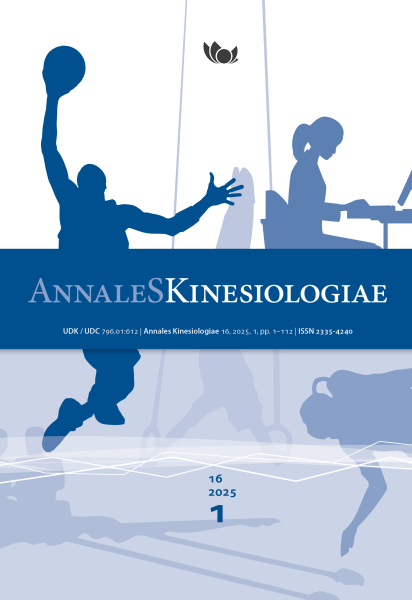Menstrual symptoms in Division I female athletes
A prospective observational study
DOI:
https://doi.org/10.35469/ak.2025.484Keywords:
menstrual cycle, team sport, hormone contraceptiveAbstract
Purpose: To quantify the frequency of menstrual cycle (MC) symptoms experienced by Division I female lacrosse athletes and to discover if the symptoms were different among those who were taking a hormone contraceptive (HC) compared to those who were not (non-HC).
Methods: As part of a daily wellness survey, athletes (non-HC = 10, HC = 11) were asked if they were menstruating. If they were, they were asked to identify any symptoms they were experiencing. The symptoms were recorded for each day of menstruation during their four-month competitive season. Reported symptoms were categorized as frequently, sometimes, rarely, or never. The frequencies of symptoms were tabulated in total and per cycle for each group.
Results: The most frequently reported symptom was cramps with 90.4% of athletes reporting experiencing it at least once. Headaches (66%), back pain, and skin problems (57% each) were also frequently reported. HC users (0.7 ± 1.4 times/cycle) reported mood swings more frequently than non-HC users (0.03 ± 0.08, p = 0.029), but there were no other group differences for symptoms.
Conclusions: Tracking symptoms associated with MC can help athletes and coaches be aware of patterns and incorporate methods for mitigating or alleviating the symptoms. Symptom tracking can also help athletes mentally prepare for the effects of their MC on training and performance. More research is needed before recommending HC use as a management strategy for menstrual symptoms.
Downloads
References
Antero, J., Golovkine, S., Niffoi, L., Meignié, A., Chassard, T., Delarochelambert, Q., … Toussaint, J. F. (2023). Menstrual cycle and hormonal contraceptive phases’ effect on elite rowers’ training, performance and wellness. Frontiers in Physiology, 14, 1110526. https://doi.org/10.3389/fphys.2023.1110526
Bozzini, B. N., McFadden, B. A., Elliott-Sale, K. J., Swinton, P. A., & Arent, S. M. (2021). Evaluating the effects of oral contraceptive use on biomarkers and body composition during a competitive season in collegiate female soccer players. Journal of Applied Physiology, 130(6), 1971-1982. https://doi.org/10.1152/japplphysiol.00818.2020
Brown, N., Knight, C. J., & Forrest (Née Whyte), L. J. (2021). Elite female athletes’ experiences and perceptions of the menstrual cycle on training and sport performance. Scandinavian Journal of Medicine & Science in Sports, 31(1), 52-69. https://doi.org/10.1111/sms.13818
Brown, N., Martin, D., Waldron, M., Bruinvels, G., Farrant, L., & Fairchild, R. (2024). Nutritional practices to manage menstrual cycle related symptoms: A systematic review. Nutrition Research Reviews, 37(2), 352–375. https://doi.org/10.1017/S0954422423000227
Bruinvels, G., Goldsmith, E., Blagrove, R., Simpkin, A., Lewis, N., Morton, K., … Pedlar, C. (2021). Prevalence and frequency of menstrual cycle symptoms are associated with availability to train and compete: A study of 6812 exercising women recruited using the Strava exercise app. British Journal of Sports Medicine, 55(8), 438-443. https://doi.org/10.1136/bjsports-2020-102792
Carmichael, M. A., Thomson, R. L., Moran, L. J., & Wycherley, T. P. (2021). The impact of menstrual cycle phase on athletes’ performance: A narrative review. International Journal of Environmental Research and Public Health, 18(4), Article 4. https://doi.org/10.3390/ijerph18041667
Cohen, J. (1988). Statistical power analysis for the behavioral sciences (2nd ed). L. Erlbaum Associates.
Findlay, R. J., Macrae, E. H. R., Whyte, I. Y., Easton, C., & Forrest (Née Whyte), L. J. (2020). How the menstrual cycle and menstruation affect sporting performance: Experiences and perceptions of elite female rugby players. British Journal of Sports Medicine, 54(18), 1108-1113. https://doi.org/10.1136/bjsports-2019-101486
Gaskins, A. J., Wilchesky, M., Mumford, S. L., Whitcomb, B. W., Browne, R. W., Wactawski-Wende, J., … Schisterman, E. F. (2012). Endogenous reproductive hormones and C-reactive protein across the menstrual cycle: The BioCycle study. American Journal of Epidemiology, 175(5), 423–431. https://doi.org/10.1093/aje/kwr343
Gasperi, L., Sansone, P., Gómez-Ruano, M.-Á., Lukonaitienė, I., & Conte, D. (2023). Female basketball game performance is influenced by menstrual cycle phase, age, perceived demands and game-related contextual factors. Journal of Sports Sciences, 43(1), 117–124. https://doi.org/10.1080/02640414.2023.2285119
Hayward, E., Akam, L., Hunter, D., & Mastana, S. (2024). Role of the menstrual cycle on performance and injury risk: A survey of female professional rugby players in the United Kingdom. International Journal of Environmental Research and Public Health, 21(2), 150. https://doi.org/10.3390/ijerph21020150
Humphries, H., Marchelli, G., & Bunn, J. A. (2024). The influence of menstruation and hormonal birth control on the performance of female collegiate lacrosse players. Sports, 12(11), 297. https://doi.org/10.3390/sports12110297
Julian, R., Hecksteden, A., Fullagar, H. H. K., & Meyer, T. (2017). The effects of menstrual cycle phase on physical performance in female soccer players. PloS One, 12(3), e0173951. https://doi.org/10.1371/journal.pone.0173951
Kannan, P., Chapple, C. M., Miller, D., Claydon, L. S., & Baxter, G. D. (2015). Menstrual pain and quality of life in women with primary dysmenorrhea: Rationale, design, and interventions of a randomized controlled trial of effects of a treadmill-based exercise intervention. Contemporary Clinical Trials, 42, 81–89. https://doi.org/10.1016/j.cct.2015.03.010
Ma, H., Hong, M., Duan, J., Liu, P., Fan, X., Shang, E., … Tang, Y. (2013). Altered cytokine gene expression in peripheral blood monocytes across the menstrual cycle in primary dysmenorrhea: A case-control study. PloS One, 8(2), e55200. https://doi.org/10.1371/journal.pone.0055200
Marchelli, G., Humphries, H., & Bunn, J. A. (2025). An analysis of wellness responses in female lacrosse athletes throughout their menstrual cycle. Exercise, Sport, and Movement, 3(3), e00049. https://doi.org/10.1249/ESM.0000000000000049
Martin, D., Sale, C., Cooper, S. B., & Elliott-Sale, K. J. (2018). Period prevalence and perceived side effects of hormonal contraceptive use and the menstrual cycle in elite athletes. International Journal of Sports Physiology and Performance, 13(7), 926–932. https://doi.org/10.1123/ijspp.2017-0330
Mauvais-Jarvis, F., Clegg, D. J., & Hevener, A. L. (2013). The role of estrogens in control of energy balance and glucose homeostasis. Endocrine Reviews, 34(3), 309–338. https://doi.org/10.1210/er.2012-1055
McGawley, K., Sargent, D., Noordhof, D., Badenhorst, C. E., Julian, R., & Govus, A. D. (2023). Improving menstrual health literacy in sport. Journal of Science and Medicine in Sport, 26(7), 351–357. https://doi.org/10.1016/j.jsams.2023.06.007
McKay, A. K. A., Minahan, C., Harris, R., Mccormick, R., Skinner, J., Ackerman, K. E., & Burke, L. M. (2024). Female Athlete Research Camp: A unique model for conducting research in high-performance female athletes. Medicine & Science in Sports & Exercise, 56(4), 706-716. https://doi.org/10.1249/MSS.0000000000003354
McNamara, A., Harris, R., & Minahan, C. (2022). ‘That time of the month’ … for the biggest event of your career! Perception of menstrual cycle on performance of Australian athletes training for the 2020 Olympic and Paralympic Games. BMJ Open Sport & Exercise Medicine, 8(2), e001300. https://doi.org/10.1136/bmjsem-2021-001300
Modena, R., Bisagno, E., Schena, F., Carazzato, S., & Vitali, F. (2022). How do elite female athletes cope with symptoms of their premenstrual period? A study on Rugby Union and football players’ perceived physical ability and well-being. International Journal of Environmental Research and Public Health, 19(18), 11168. https://doi.org/10.3390/ijerph191811168
Mu, E., & Kulkarni, J. (2022). Hormonal contraception and mood disorders. Australian Prescriber, 45(3), 75–79. https://doi.org/10.18773/austprescr.2022.025
O’Brien, S., Rapkin, A., Dennerstein, L., & Nevatte, T. (2011). Diagnosis and management of premenstrual disorders. BMJ, 342, d2994. https://doi.org/10.1136/bmj.d2994
Oester, C., Norris, D., Scott, D., Pedlar, C., Bruinvels, G., & Lovell, R. (2024). Inconsistencies in the perceived impact of the menstrual cycle on sport performance and in the prevalence of menstrual cycle symptoms: A scoping review of the literature. Journal of Science and Medicine in Sport, 27(6), 373-384. https://doi.org/10.1016/j.jsams.2024.02.012
Oxfeldt, M., Dalgaard, L. B., Jørgensen, A. A., & Hansen, M. (2020). Hormonal contraceptive use, menstrual dysfunctions, and self-reported side effects in elite athletes in Denmark. International Journal of Sports Physiology and Performance, 15(10), 1377–1384. https://doi.org/10.1123/ijspp.2019-0636
Parker, L. J., Elliott-Sale, K. J., Hannon, M. P., Morton, J. P., & Close, G. L. (2022). An audit of hormonal contraceptive use in Women’s Super League soccer players; implications on symptomology. Science & Medicine in Football, 6(2), 153–158. https://doi.org/10.1080/24733938.2021.1921248
Powell, A. (2017). Choosing the right oral contraceptive pill for teens. Pediatric Clinics of North America, 64(2), 343–358. https://doi.org/10.1016/j.pcl.2016.11.005
Puder, J. J., Blum, C. A., Mueller, B., De Geyter, C., Dye, L., & Keller, U. (2006). Menstrual cycle symptoms are associated with changes in low-grade inflammation. European Journal of Clinical Investigation, 36(1), 58–64. https://doi.org/10.1111/j.1365-2362.2006.01591.x
Roffler, A., Fleddermann, M.-T., de Haan, H., Krüger, K., & Zentgraf, K. (2024). Menstrual cycle tracking in professional volleyball athletes. Frontiers in Sports and Active Living, 6, 1408711. https://doi.org/10.3389/fspor.2024.1408711
Schulz, J. M., Pohlod, L., Myers, S., Chung, J., & Thornton, J. S. (2025). Are female athlete specific health considerations being assessed and addressed in preparticipation examinations? A scoping review and proposed framework. Journal of Sport and Health Science, 14, 100981. https://doi.org/10.1016/j.jshs.2024.100981
Scott, D., Bruinvels, G., Norris, D., & Lovell, R. (2024). The dose-response in elite soccer: preliminary insights from menstrual-cycle tracking during the FIFA Women’s World Cup 2019. International Journal of Sports Physiology and Performance, 19(4), 331–339. https://doi.org/10.1123/ijspp.2022-0282
Taim, B. C., Ó Catháin, C., Renard, M., Elliott-Sale, K. J., Madigan, S., & Ní Chéilleachair, N. (2023). The prevalence of menstrual cycle disorders and menstrual cycle-related symptoms in female athletes: A systematic literature review. Sports Medicine (Auckland, N.Z.), 53(10), 1963–1984. https://doi.org/10.1007/s40279-023-01871-8
Thornton, A. R., Figueroa, Y., Davis, P., & Bunn, J. A. (2023). Comparision of game data between halves and quarters in Division I women’s lacrosse. Journal of Science in Sport and Exercise. https://doi.org/10.1007/s42978-023-00260-x
Vaghela, N., Mishra, D., Sheth, M., & Dani, V. B. (2019). To compare the effects of aerobic exercise and yoga on Premenstrual syndrome. Journal of Education and Health Promotion, 8(1), 199. https://doi.org/10.4103/jehp.jehp_50_19
Vogel, K., Larsen, B., McLellan, C., & Bird, S. P. (2024). Female athletes and the menstrual cycle in team sports: Current state of play and considerations for future research. Sports, 12(1), 4. https://doi.org/10.3390/sports12010004
Yonkers, K. A., & Simoni, M. K. (2018). Premenstrual disorders. American Journal of Obstetrics and Gynecology, 218(1), 68–74. https://doi.org/10.1016/j.ajog.2017.05.045
Downloads
Published
How to Cite
Issue
Section
License
Copyright (c) 2025 Jennifer Bunn, Gabrielle Marchelli, Hannah Humphries

This work is licensed under a Creative Commons Attribution 4.0 International License.
Open Access Policy and Copyright
This journal provides immediate open access to its content on the principle that making research freely available to the public supports a greater global exchange of knowledge. Users are allowed to read, download, copy, distribute, print, search, or link to the full texts of the articles, or use them for any other lawful purpose, without asking prior permission from the publisher or the author.
Authors who publish with this journal agree to the following terms:
- Authors retain copyright and grant the journal right of first publication with the work simultaneously licensed under the terms of the Creative Commons Attribution license (CC BY) that allows others to share the work with an acknowledgement of the work’s authorship and initial publication in this journal.
- Authors grant the publisher commercial rights to produce hardcopy volumes of the journal for sale to libraries and individuals.
- Authors are able to enter into separate, additional contractual arrangements for the non-exclusive distribution of the journal’s published version of the work (e.g., post it to an institutional repository or publish it in a book), with an acknowledgement of its initial publication in this journal.








